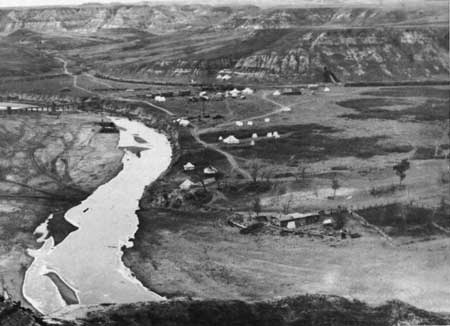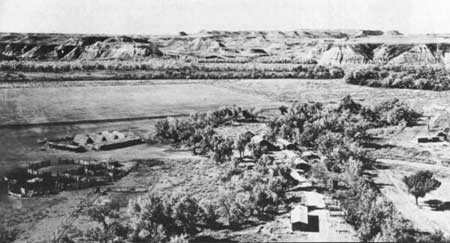|
Theodore Roosevelt and the Dakota Badlands |
 |

Buffalo hides awaiting shipment, Dickinson, N.
Dak., 1882.
The Town of Little Missouri
The early surveying parties, soldiers, and construction workers noted the abundance of wildlife in the Little Missouri Badlands. No sooner had the Northern Pacific Railway reached the Little Missouri River in September 1880 than the exploitation of the region as a game country began. Frank Moore's Pyramid Park Hotel, completed near the Badlands Cantonment in the same year, served as an outfitting point for hunting parties. Newspapers in Dakota publicized the country as a hunters' paradise. The Bismarck Tribune in February 1880 claimed that 2 hunters in 6 weeks' time killed 90 deer and antelope and 15 elk. It alleged that they shot 11 of the elk in about 15 minutes. Other Dakota newspapers made similar claims. E. G. Paddock and Howard Eaton, professional guides for hunting groups, ran a continuous advertisement in the Mandan Pioneer.
The Northern Pacific cooperated in publicizing the region through its tourist brochures. In them, the railroad endeavored to change the name of the region along its right-of-way from the "Badlands" to "Pyramid Park." The company continued to use this name in its tourist and sales literature until recent times.
The publicity given the region by the railroad and newspapers was soon to affect its development. When the Badlands Cantonment was abandoned early in 1883, E. G. Gorringe, a retired naval officer, arranged to convert the buildings into a tourist resort. Before abandonment of the cantonment, a settlement named Little Missouri, and commonly called "Little Misery," had sprung up about half a mile southeast of it on the western bank of the river. In spite of the fact that Little Missouri soon earned a reputation for being a "wide open town," the excellent hunting in the vicinity attracted a number of easterners and foreigners, among them the Marquis de Mores, Howard and Alton Eaton, A. C. Huidekoper, and Theodore Roosevelt. Some of these people thought the region had potentialities as a cattle country and invested heavily in the livestock business.

"Little Misery." Paddock's cabin in foreground,
1880. Courtesy Haynes Studios Inc.
Many Texas cattlemen also became interested in the northern ranges where the nutritious grasses fattened cattle more easily than the grasslands of the southern plains. Several Texas outfits developed ranches on the upper part of the Little Missouri River in present South Dakota and Montana. About this time, a Minnesota outfit, Wadsworth and Hawley, occupied a site on the Little Missouri about 15 miles north of the new settlement of "Little Misery." And about the same time Howard Eaton and E. G. Paddock established a ranch 5 miles south of the new town.
By the end of 1883 there were a number of outfits along the Little Missouri which were largely financed by Texas, eastern, or foreign capital. Among these were the OX Ranch, near present Marmarth; the Benny, Boice Cattle Company, known as the "Three Sevens" (777); and the Continental Land and Cattle Company, commonly called the "Hashknife." All three were Texas firms. Others were the Neimmela Ranch, financed by Sir John Pender of London; the Custer Trail Ranch, owned by a Pennsylvania family; and the Marquis de Mores operations, which had the financial backing of both eastern and foreign capital.

Custer Trail Ranch. Courtesy Osborn
Studios.

|

|
|
Last Modified: Sat, Jan 17 2004 10:00:00 am PDT |


